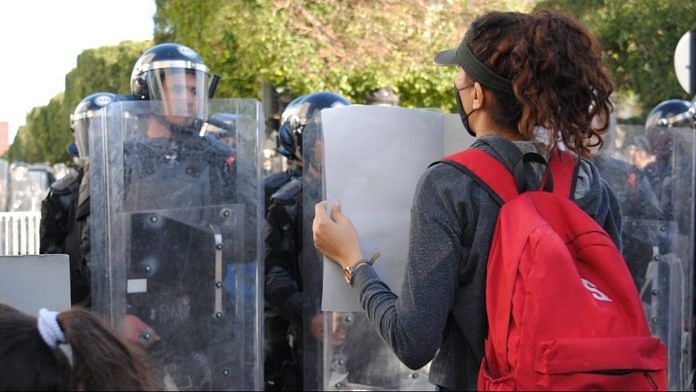Twenty-nine-year-old Raghda Fhoula is back at the protest, 10 years after she screamed her lungs out with slogans against then-Tunisian regime at ground zero of the Arab Spring movement. On 23 January 2021, she was at the frontlines in capital Tunis, calling for the fall of Hichem Mechichi and Rached Ghannouchi’s regime, and for “work, freedom, and national dignity”. Because the “revolution” was incomplete.
Tunisia is still waiting for one, Raghda says. “The system of (then-president Zine el-Abidine) Ben Ali hasn’t departed,” she tells me. Besides her, scores of Arab Spring activists are back on the streets after a decade. There is some contention, though, on describing the past protests. Some agree with calling it a “revolution”, because it brought the fall of the dictatorship; some called it the “Jasmine revolution”, after the national flower of Tunisia, which was critiqued as catering to “exotic imaginary” — call it the “revolution of dignity and freedom”, they proposed. Still others called it a “Facebook revolution”, in a nod to the popular use of social media during the protests. But Raghda calls it “intifada” — an uprising.
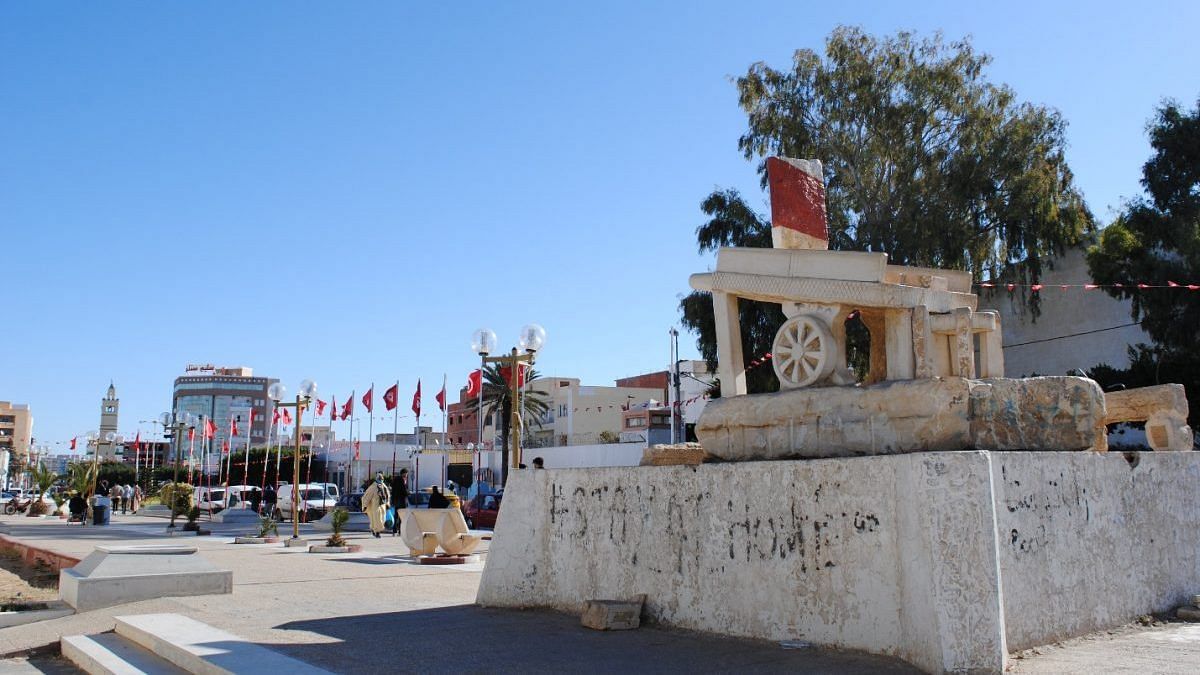
On 17 December 2010, in Sidi Bouzid Governorate, around 300 km south of Tunis, Mohamed Bouazizi, whose vegetable cart the police had confiscated, immolated himself. His desperate act inspired mass protests, which soon spread throughout the country, only to be violently suppressed. At the time, no one imagined that Ben Ali’s government would fall or that he would leave the country, which he did on the night of 14 January 2011, marking the end of 23 years of his authoritarian rule.
Raghda’s face lights up as she recalls the moment she heard the news. “We felt like we had won,” she tells me, a happy end to her and her comrades’ efforts, since 2005, in organising protests, alternative radios, and other acts of resistance.
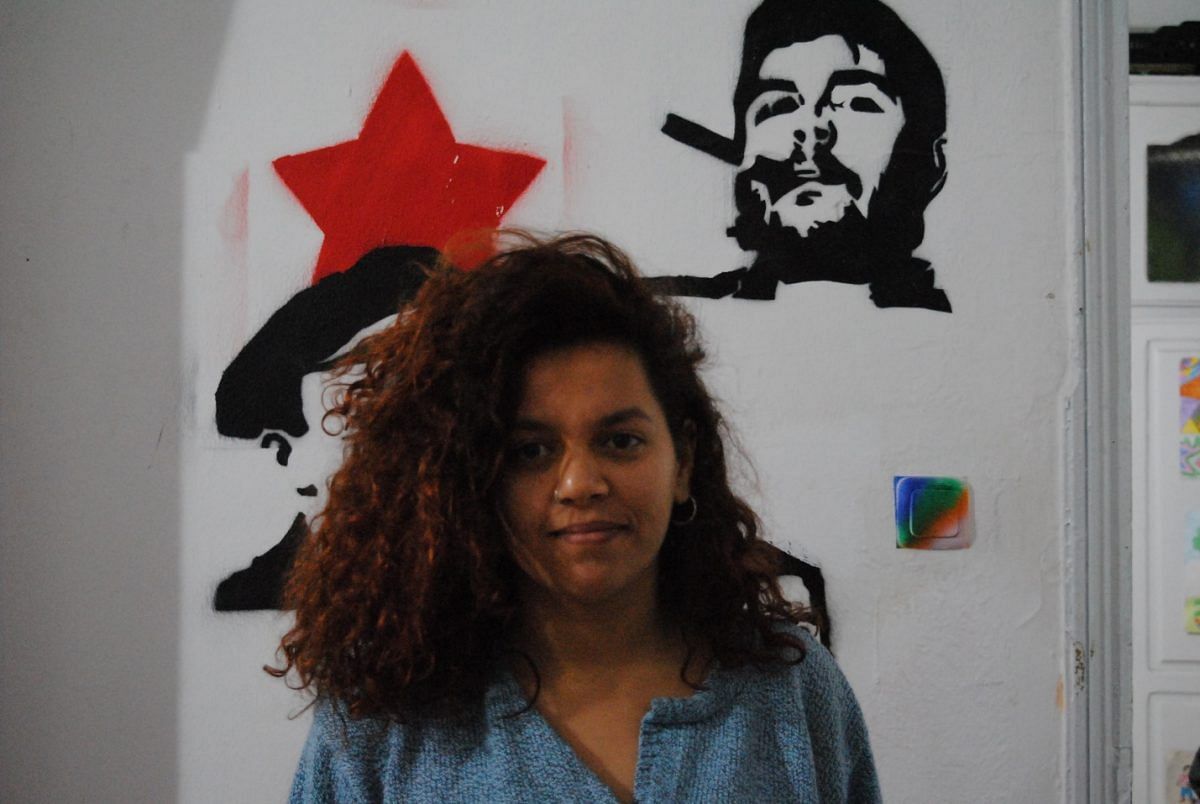
The surprising success of Tunisians in bringing down a dictatorship inspired similar mass protests in the region, including in Egypt, Libya, Syria, and Yemen. Together, they became the Arab Spring. Protest slogans from Tunisia were adapted and moulded into local cultures, shouted or sung with music. Each country took a separate trajectory. While Egypt’s long-running dictatorship came to an end, Syria witnessed an increase in State repression through more violent means. But through all this, the Tunisian story of democracy continued to be hailed as a “model” for the region, making the North African country ground zero of the Arab Spring.
The government-imposed lockdown starting the day of the 10-year-anniversary of the departure of Ben Ali to suppress the celebration of this important date, and the night clashes that followed between young men and police in the popular neighbourhoods of Tunisian cities put to question this rhetoric of “model democracy.” As scholar Olfa Lamloum writes, “Ben Ali’s successors have betrayed the revolution’s promise of dignity. In a sign of the times, the term ‘revolution’ has been replaced by the expression ‘democratic transition’, which is a subtle way of denying political legitimacy to those who led the protests.”
Also read: Arab Spring showed autocracy is anything but stable
A police state
The security infrastructure with ever-present police seeking to crush any act of resistance has brought the Tunisians out on the streets once again. While the police state had momentarily disappeared post-2011, the country under Prime Minister Hichem Mechichi and President Kaïs Saïed is slowly returning to the same forms of repressive rule that existed under Ben Ali.
For Raghda, and many others, who witnessed police violence both before and after 2011, little has changed. In 2008, when she was still a minor, Raghda was questioned by the police for more than four hours for her activism against the Ben Ali regime. In 2016, she and her group of friends were detained for playing music on the streets of Tunis. Harsh questioning, police violence, and arrests are common.
It isn’t surprising, therefore, that recent protests call for an end to the police state. About 23,000 people in Tunisia are currently in jail, according to recent estimates by Lawyers Without Frontiers association. These numbers haven’t changed drastically over the years. Imprisonment continues to be a significant aspect in the lives of Tunisians across the country, and frequent prison transfer means that families are forced to travel long distances to see their loved ones.
Since the beginning of the nightly clashes on 14 January 2021, a date that coincided with the 10th anniversary of the fall of Ben Ali’s regime as well as the start of a four-day lockdown, more than 1,600 people have been arrested, including activists. Around 600 of those are minors.
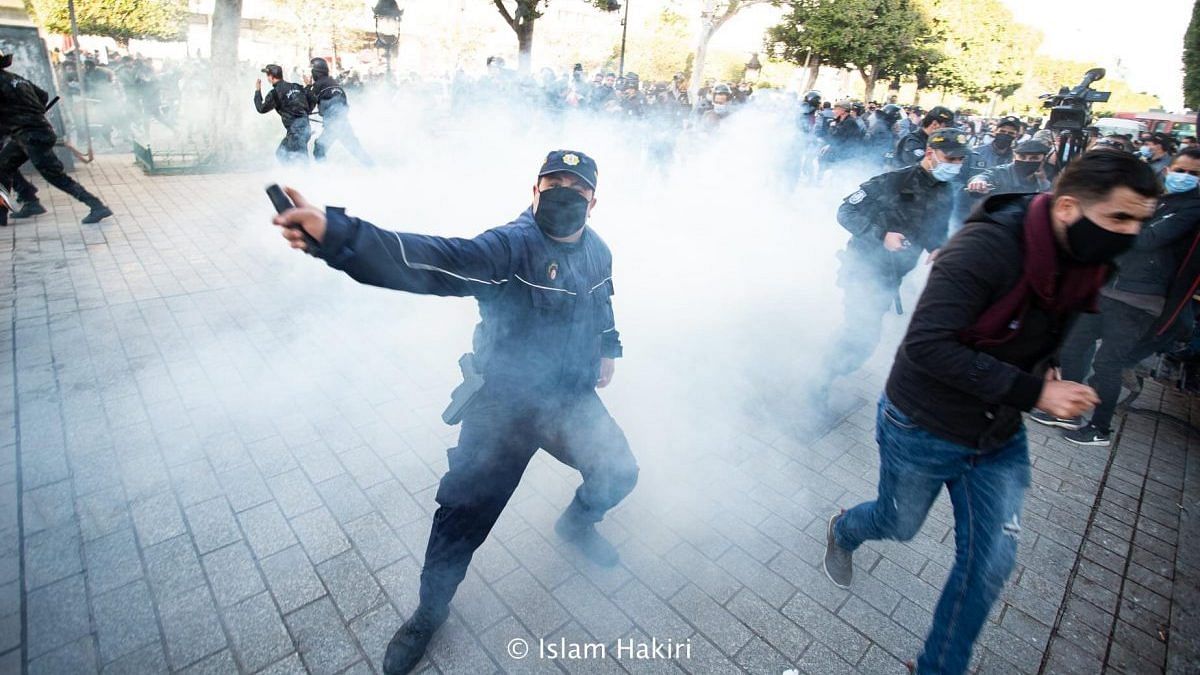
Violence and torture are common in Tunisian prisons. As Zakia Yaakoubi, mother of a 16-year-old detained recently, testified: “When I rushed after [my son] to the police station, he was all covered in mud and they were kicking him around like a ball.”
But the Tunisian government and its media apparatus don’t define the night clashes as ‘protests’ and refer to them as ‘rioters’ instead, playing on the binary of so-called ‘peaceful’ protesters usually found in the city centre of Tunis and the younger men from popular neighbourhoods who “steal” and “vandalise”. Many of my non-Tunisian friends who remain critical of the government call these night clashes “unstructured” acts that would lead the protesters “nowhere”. But what is clear is that, more than the so-called ‘peaceful’ protests, it is the acts of stealing that receive maximum government attention.
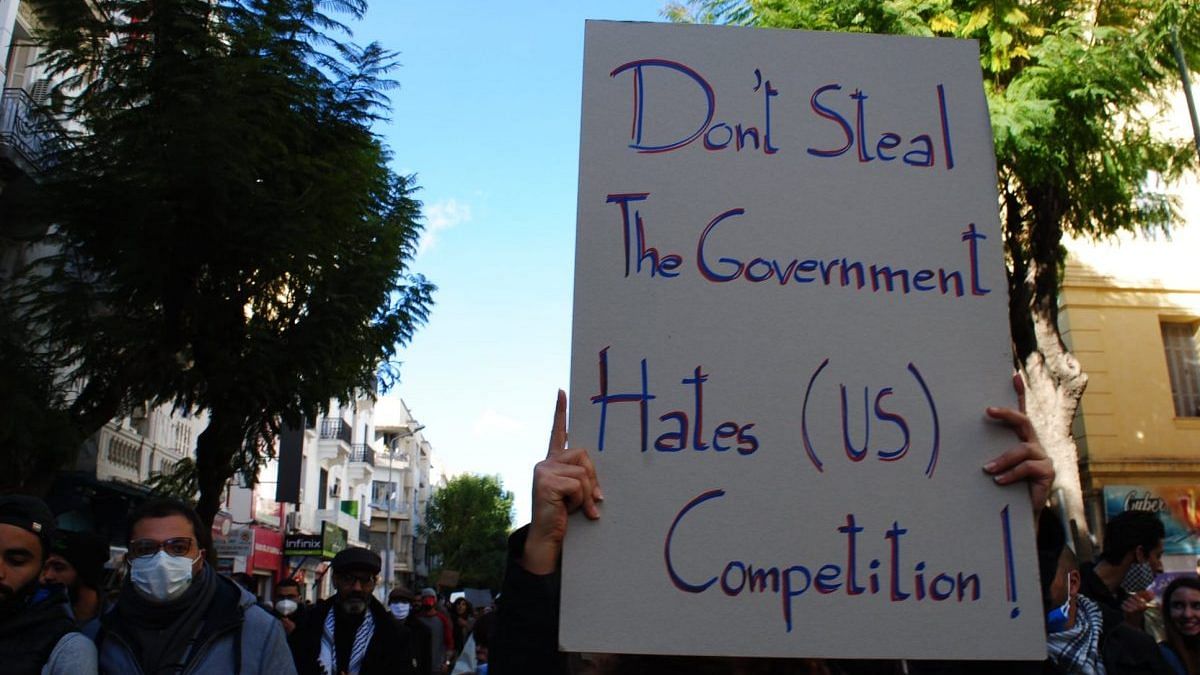
Also read: Why Egypt didn’t profit from peace with Israel as the UAE will
Young and restless
Increasing inequalities and experiences of loss of dignity are stories I hear everywhere. Raghda says even though she is employed by a public institution, she has no official ‘contract’, which makes her ineligible for free healthcare, a precarity she carries as a burden in the middle of the Covid pandemic. As a teacher to autistic children, Raghda earns 500 Tunisian dinars a month (around Rs 13,500), half of which goes towards her rent.
Education continues to be hailed as a path to social mobility. Raghda has a master’s degree in philosophy, and is finishing an undergraduate degree in music. But degrees no longer translate into stable jobs. This has led to many students losing the motivation to study, says Houda (name changed), an English teacher in Tabarka on the northern coast of Tunisia.
Many complain that the young generation of today is the problem. But Mhamed M., a public-school teacher in Sidi Bouzid Governorate for more than two decades, tells me that the education system remains what it was in the 1950s-60s, with no structural changes to respond to the evolving needs of the labour market.
Stories of marginalisation match with the findings of quantitative studies on the economic and social inequalities in Tunisia. Today, unemployment in the country remains high (around 16 per cent since 2013), concentrated largely among the youth — around 37 per cent of those aged between 15-24 years were unemployed in 2020 (World Bank). Tunisia’s development has not been evenly distributed geographically; marginalisation of southern and central regions (like Sidi Bouzid) is prominent in spite of them being rich in natural resources.
Also read: What ails Arab economies is older than Covid-19
Nostalgic of the past
The worsening economic situation, especially in light of the Covid pandemic, has turned some people nostalgic about the Ben Ali era, reflected also in the rise of politicians close to the former president, like Abir Moussi. With the increase in economic uncertainty, Ben Ali’s rule has been reimagined as having been “much more reliable than now”, says Michaël Bechir Ayari, senior analyst at the International Crisis Group think tank.
For the nostalgic ones, the events of 2010-11 marked the fall of Tunisian society. Abir Jlassi, a 27-year-old law student says, “What happened was not a revolution, what happened was a coup d’état.” Parliamentarian Mohammed Krifa of the Free Destourian Party says, “If you give us freedom of speech and we are starving, what does that mean?” Freedom of speech has been hailed as one of the biggest achievements coming out of the fall of the Ben Ali regime; questioning it also puts in question the significance of the events of 2010-11 and their fallout.
Since the departure of Ben Ali, a multitude of political parties have emerged in Tunisia, most prominently Ennahdha – a “moderate Islamist party” – headed by Rached Ghannouchi, which was banned under Ben Ali but remains a strong voice today. Election results point to increasing polarisation between the Islamic and secular parties, resulting in fractured governing structures.
Also read: Lessons from Occupy Wallstreet to Arab Spring — young people must adopt mature activism
A forever revolution
For Raghda and others, though, the ‘revolution’ continues. The slogans that marked the protests 10 years ago have returned, most prominently – “The people want the fall of the regime”. So what has changed this time? According to scholar Hela Yousfi, the last ten years have witnessed the creation of “a new political imagination by the citizens who are resisting, and from which new social relations are emerging”. These relations are based on a new concept of power – autonomous, separate from the classical institutional power, and one that rejects State oppression.
This rejection of submitting to the State’s whims and desires is what I see as I walk with the protesting Tunisian youth. Coming to a protest site, in the middle of a pandemic, knowing that you could be subjected to police violence, is an act of resistance and rejection of the State power. Groups gather away from the protest site as police shoot tear gas; they tell me not to use water to clean my eyes. They share cartons of milk to wash their faces and squeeze lemons onto their face mask. The revolution continues, with milk and lemons.
The author is a doctoral scholar studying political sociology. Her research focuses on the study of racism, religion, and contestations of identities in Tunisia and France. She tweets @shreya_parikh. Views are personal.


